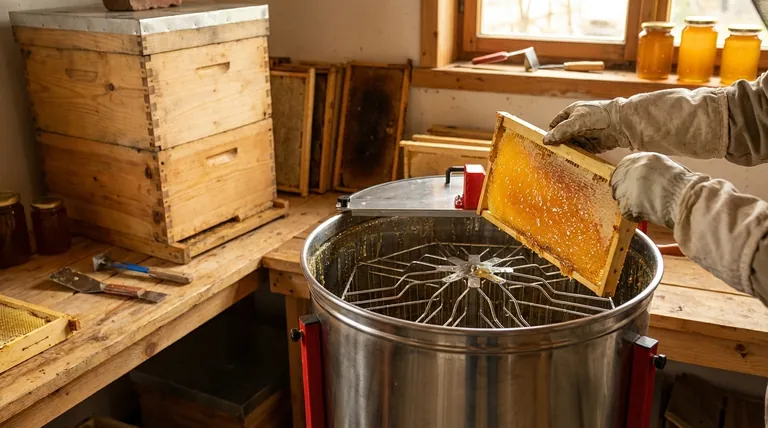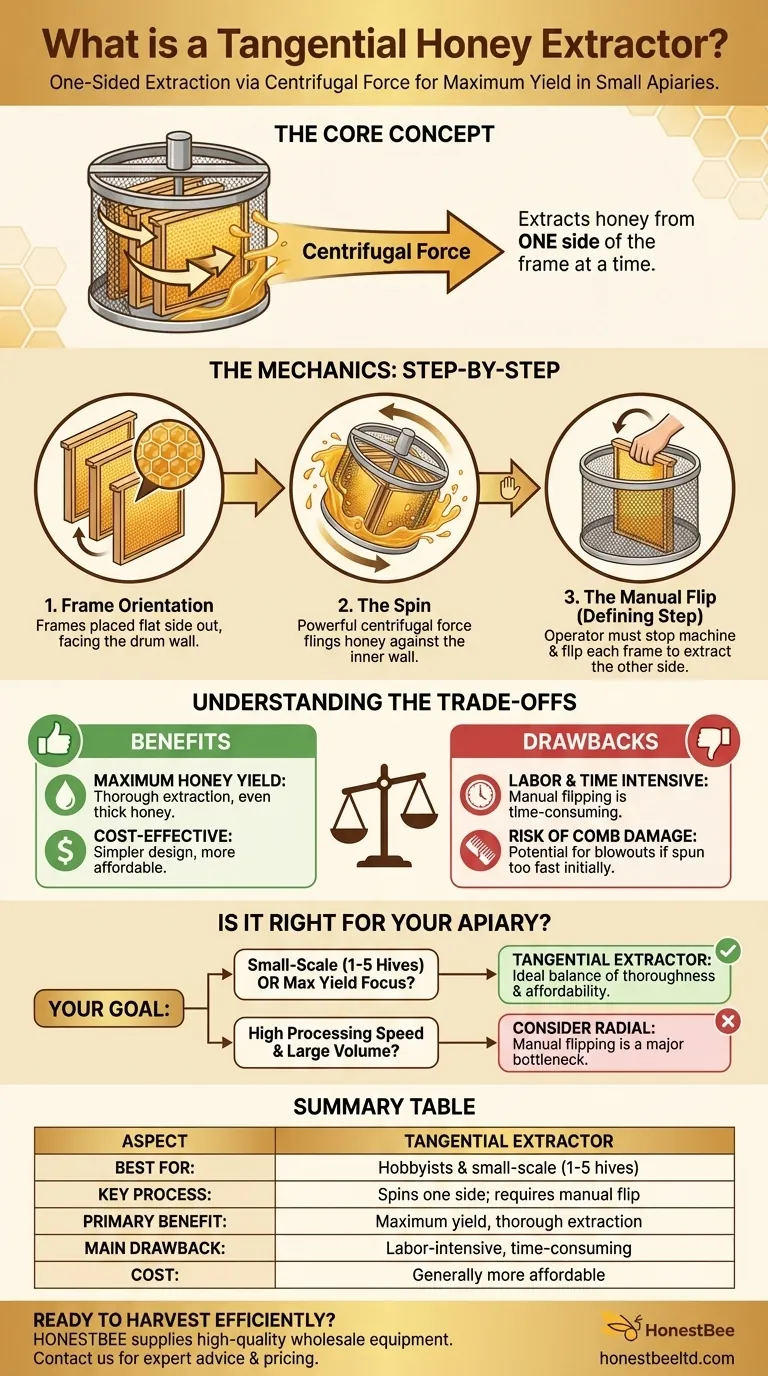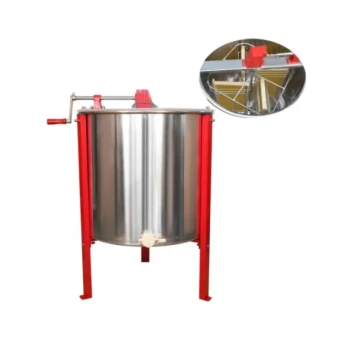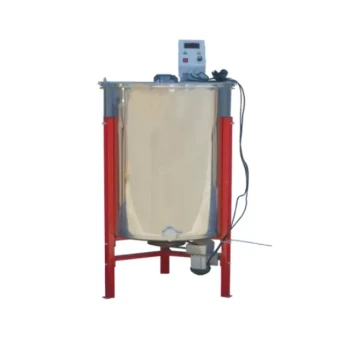In essence, a tangential honey extractor is a machine that uses centrifugal force to pull honey from one side of a frame at a time. It is designed for thoroughness and is a common choice for hobbyists and small-scale beekeepers. To complete the process, the beekeeper must stop the machine, manually flip each frame, and then spin it again to extract the honey from the second side.
The defining characteristic of a tangential extractor is its one-sided extraction process. While this requires more manual effort to flip each frame, it allows for a highly efficient and complete harvest, making it a practical choice for beekeepers managing a smaller number of colonies.

The Mechanics of Tangential Extraction
To understand why this design is so effective for its intended purpose, it's important to look at how it operates step-by-step. The process is a simple application of physics tailored for the small apiary.
Frame Orientation and Placement
In a tangential extractor, the frames are placed in a cage or basket. Each frame stands on its end, with one of the flat faces of the honeycomb resting against the outer mesh wall of the cage.
This orientation ensures that the honey-filled cells are facing directly outward, perpendicular to the center of the drum.
The Role of Centrifugal Force
When the extractor spins, it generates a powerful centrifugal force. This force pulls the honey directly out of the uncapped cells and flings it against the inner wall of the extractor drum.
From there, the honey drips down the wall and collects at the bottom, where it can be drained through a gate or valve.
The Manual Flip: The Defining Step
Because the force is only applied to the outward-facing side of the comb, the cells on the inner side remain full. This necessitates the key step that defines tangential extraction.
The operator must stop the spinning, open the extractor, and manually turn each frame around so the other side faces outward. The process is then repeated to empty the second side of the comb.
Understanding the Trade-offs
While effective, the tangential design comes with a distinct set of advantages and disadvantages that make it suitable for some beekeepers but less ideal for others.
Benefit: Maximum Honey Yield
The primary advantage is its thoroughness. The direct, outward force is extremely effective at removing all the honey from the cells, even very thick or crystallized honey that might be left behind in other extractor types.
Benefit: Cost-Effectiveness
Tangential extractors often have a simpler design compared to other models. This simplicity generally makes them more affordable, which is a major benefit for new beekeepers or those on a budget.
Drawback: Labor and Time
The biggest trade-off is the manual labor required. Stopping the machine to flip every single frame is time-consuming. This process is manageable for a few hives but quickly becomes a significant bottleneck for larger operations.
Risk: Potential for Comb Damage
Because the force is applied unevenly—pulling on one side of a full, heavy comb—there is a risk of the wax foundation "blowing out" or breaking if spun too fast initially. Experienced operators often mitigate this by partially extracting the first side at a lower speed before flipping to the heavier, second side.
Making the Right Choice for Your Apiary
Ultimately, the decision to use a tangential extractor depends entirely on the scale and goals of your beekeeping operation.
- If your primary focus is managing a few hives (1-5): A tangential extractor offers the perfect balance of thorough extraction and affordability for your scale.
- If your primary focus is maximizing honey yield from every frame: The direct force of a tangential extractor ensures a highly complete harvest, especially with thick honey.
- If your primary focus is processing speed for a large number of frames: You should consider a radial extractor, as the manual flipping required by a tangential model becomes a major time constraint.
Understanding this core mechanism empowers you to select the right tool for the specific needs of your beekeeping journey.
Summary Table:
| Aspect | Tangential Extractor |
|---|---|
| Best For | Hobbyists & small-scale beekeepers (1-5 hives) |
| Key Process | Spins one side of the frame at a time; requires manual flipping |
| Primary Benefit | Maximum honey yield, even thick or crystallized honey |
| Main Drawback | More labor-intensive and time-consuming than radial models |
| Cost | Generally more affordable and cost-effective |
Ready to Harvest Your Honey Efficiently?
As a beekeeper, you know that the right equipment is key to a successful harvest. HONESTBEE supplies high-quality beekeeping supplies and equipment to commercial apiaries and distributors through our wholesale-focused operations.
Whether you're a hobbyist looking for your first extractor or a distributor stocking up for the season, we provide the durable, reliable tools you need. Let's discuss how our equipment can support your beekeeping success.
Contact HONESTBEE today for wholesale pricing and expert advice!
Visual Guide

Related Products
- Stainless Steel Manual 8 Frame Radial Honey Extractor Machine for Beehives
- 2 Frame Stainless Steel Manual Honey Spinner Extractor for Beekeeping
- HONESTBEE 72 Frame Industrial Electric Honey Extractor for Beekeeping
- 6 Frame Manual Stainless Steel Honey Extractor Beekeeping Equipment
- HONESTBEE 3-Frame Manual Acrylic Honey Extractor
People Also Ask
- What should a beekeeper do after extracting honey from supers? A Guide to Harvest Management
- What are the advantages of tangential honey extractors? Gentle, Affordable Honey Extraction for Your Apiary
- What are radial honey extractors and what are their features? Maximize Your Honey Harvest Efficiency
- What is the difference between a radial extractor and a tangential extractor? Choose the Right Extractor for Your Apiary
- What is the difference between radial and tangential honey extractors? Choose the Right Extractor for Your Harvest



















